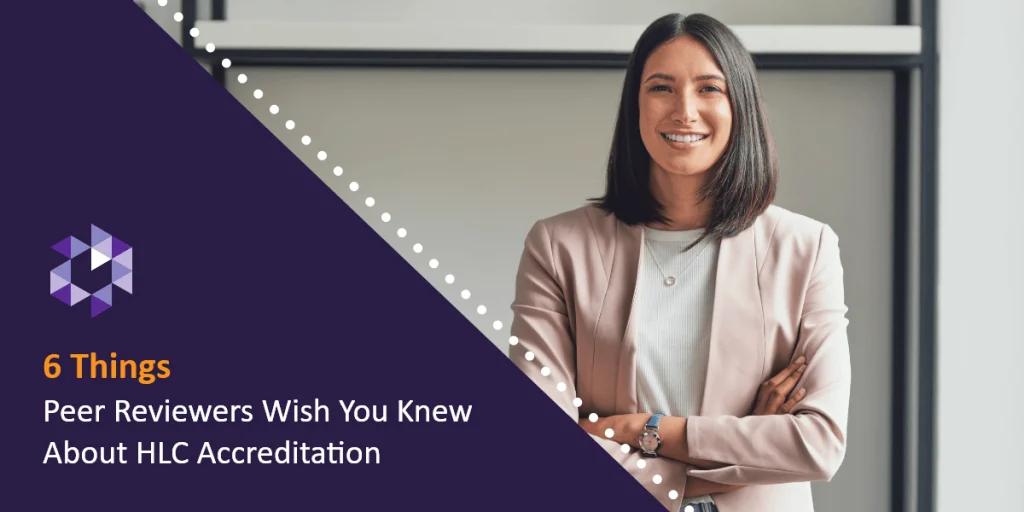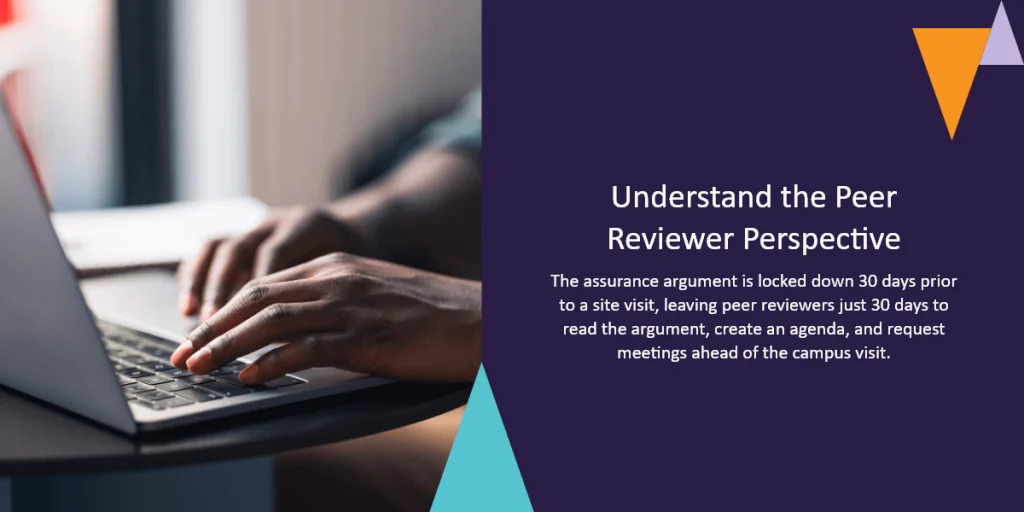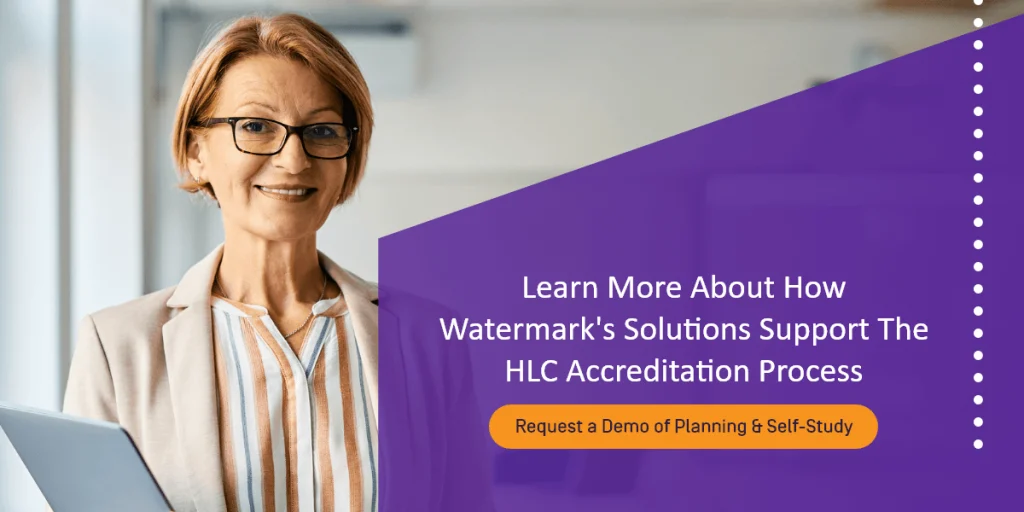




The Higher Learning Commission (HLC) assurance argument is a rigorous process for those on campus preparing materials, and for the peer reviewers who review them, visit campus, and report on their findings. Peer reviewers Kathy Adair, Director of Development and Assessment at Bay Mills Community College, and Summer DeProw, Interim Assistant Vice Chancellor for Academic Affairs and Director of Assessment at Arkansas State University, shared insights from their perspectives as peer reviewers as well as participants in accreditation reporting on their respective campuses.
Here are six key things they wish every institution knew about HLC accreditation and peer review visits.

Before they ever come to campus, peer reviewers read your assurance argument and review your supporting evidence. But Adair and DeProw often see institutions make their argument based on what they understand or believe about their institution rather than based on the evidence they include.
“My experience is that substantiating evidence put into the argument doesn’t always match the argument—maybe it didn’t make the point, maybe it’s placed in the wrong section, or maybe the evidence just didn’t go all the way to home plate in substantiating the argument,” DeProw said. “As reviewers coming in, that’s all we’ve got, so it’s our job during the site visit to authenticate or triangulate with the campus that the evidence provided is the best evidence they’ve got.”
Adair and DeProw recommend using campus systems to authenticate operational effectiveness, student satisfaction, and other areas of the assurance argument. “People have to get really comfortable pulling reports out of campus systems to drive home their argument with evidence,” DeProw said. “When you’re annually plugging your way through entering data, you’re essentially creating a repository to pull that information from over time.”
“Sometimes there’s a gap, where within the institution, we know something—we’re here every day—but that’s not substantiation. You can’t just say students are happy. Show a student survey that demonstrates they’re happy with the institution,” Adair said.
“A screenshot from the athletic department showing students cheering in the stands isn’t evidence of student engagement,” DeProw said. “But three years of student survey data showing that this population is engaged, this one isn’t, and here’s how we’re trying to get to that group—that’s evidence.”
“Pull assessment reports, interlink those into the argument to show continuous improvement and that every program was making an annual report,” DeProw said. “If you’re using a faculty activity reporting system, log faculty’s research and service as well as their teaching assignments so you can pull out of that to authenticate qualifications.”
“Data is big for reviewing,” Adair said. “Every institution has a myriad of data, but not all institutions really make good use of the data, or present it in a way that makes sense to someone who’s not inside the institution.”

The assurance argument is locked down 4 to 8 weeks prior to a site visit. (It takes 4 weeks for most non-sanction reviews, and up to 8 weeks for sanction reviews.). That leaves peer reviewers just a month or two to read the argument, create an agenda, and request meetings ahead of the campus visit. This can cause anxiety on campus, as requests for interviews may come just 10 days before the peer review team arrives.
It can also mean that peer reviewers miss evidence in the report. “We’re human,” DeProw said. She recommends having your original documentation readily available during a peer review visit, as well as additional levels of information. “Your evidence may be there and it was missed, or we don’t have time to recall it, or dig back for them,” DeProw said. “We may also want something more basic.”. “Tell us that your enrollment is down and what you’re doing to increase it. It’s much better to hear it from you rather than digging into it and finding it ourselves, and not seeing a plan for improvement.”
“Peer review isn’t a punitive function,” Adair said. “We’re there to help institutions continually improve their quality, engagement with students, and everything they do: programs, courses, co-curricular, and processes.”
Many participants are intimidated by face-to-face interviews, Adair noted. “People are afraid to admit issues. They want to paint a rosy picture. But it’s much better to tell the truth, and share the ups and downs,” Adair said. “Tell us that your enrollment is down and what you’re doing to increase it. It’s much better to hear it from you rather than digging into it and finding it ourselves, and not seeing a plan for improvement.”

Adair and DeProw are each responsible for preparing the assurance argument for their campus. They recommend sharing the completed argument and evidence with campus stakeholders who may be interviewed. DeProw held meetings ahead of ASU’s recent peer review visit. “I wanted to build their confidence to answer questions,” DeProw said. “There’s so much evidence, so many screen shots, web pages, reports, and explanations. We showed them that we’re being honest with HLC and ourselves, so there’s no reason to feel like you can’t be candid during the interviews.”
“I recommend that every institution have at least one peer reviewer,” Adair said. “It’s beneficial to have someone who has that inside view of the process. It gives the institution an understanding of the issues that come up most often.” Adair considers it invaluable training, and noted that it doesn’t cost the institution anything, as reviewers are paid by HLC—the institution just has to allow the time off. Bay Mills, a small tribal institution with 450 students, has two peer review evaluators on campus; ASU has four peer reviewers, and hopes to have more in the future. You can learn more about becoming an HLC peer reviewer here.

To learn more about how Watermark’s solutions support the HLC accreditation process, download The Essential Guide to HLC Accreditation or request a personalized demo.
©️2025 Watermark Insights, LLC or its affiliates. All Rights Reserved. Other trademarks, including Accreditation trademarks, may be trademarks of their respective owners. This article is for information purposes only. Watermark believes the information in this article is accurate as of its publication date, and the information contained herein is subject to change without notice. Watermark is not affiliated with the Accreditor and the Accreditor did not participate in the creation of this report. Watermark makes no warranties, express or implied, in this report.





























































































































































































































































































































































































